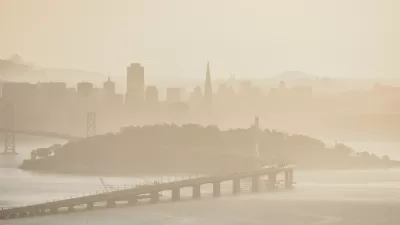With speculation that downed power lines and exploding transformers may have caused California's most deadly and destructive wildfires, many question why utility companies don't bury these lines through fire-prone areas.

Burying power lines is not cheap, costing at least twice that of an overhead line. Furthermore, the costs would be borne by the utility's customers, which not the company's profits, reports David R. Baker for the San Francisco Chronicle. And it's not just the utilities that are concerned about the added costs.
“We think it’s so expensive that it’s really not feasible,” said Mark Toney, executive director of The Utility Reform Network watchdog group. [A consumer advocacy organization headquartered in San Francisco].
Research by the Bay Area News Group did find that at least 10 problems were reported with Pacific Gas and Electric Co. (PG&E) lines on the first night of the fires that began on Sunday, Oct. 8, and are expected to be fully contained on Friday, Oct. 27.
Were the power lines responsible for causing the wildfires that have caused 42 deaths, destroyed at least 8,700 structures, and scorched over 245,000 acres [per CNBC on Oct. 26]? "The simple answer is we don’t know yet," writes Geisha Williams, CEO and president of PG&E Corp. in an op-ed for The Chronicle on Oct. 20.
In an opposing op-ed, Jamie Court, president of the nonprofit nonpartisan group Consumer Watchdog, charges PG&E with negligence for their negligence in reducing wildfire risks around their lines, and also takes aim at Gov. Brown and the California Public Utilities Commission over the vetoing a bill last year to mitigate wildfire risks from overhead utility facilities. The CPUC and CAL FIRE are both conducting investigations to determine the cause of the fires.
Baker reports extensively on the costs of undergrounding of power lines in urban areas which is done primarily for aesthetic reasons, and the costs are much higher than those in undeveloped areas.
For 10 years starting in 1996, [San Francisco] worked with PG&E to place underground 45.8 miles of overhead lines, with the utility estimating a cost of $1 million per mile. Instead, the final price came in at $3.8 million per mile [pdf].
Other utilities have been more aggressive in undergrounding power lines, such as much smaller San Diego Gas and Electric Co., a division of Sempra Energy, which has buried 60 percent of its lines, reports Baker.
FULL STORY: Underground power lines don’t cause wildfires. But they’re really expensive

Alabama: Trump Terminates Settlements for Black Communities Harmed By Raw Sewage
Trump deemed the landmark civil rights agreement “illegal DEI and environmental justice policy.”

Planetizen Federal Action Tracker
A weekly monitor of how Trump’s orders and actions are impacting planners and planning in America.

The 120 Year Old Tiny Home Villages That Sheltered San Francisco’s Earthquake Refugees
More than a century ago, San Francisco mobilized to house thousands of residents displaced by the 1906 earthquake. Could their strategy offer a model for the present?

High-Speed Rail Tracker
Smart Cities Dive follows high-speed rail developments around the country

Ken Jennings Launches Transit Web Series
The Jeopardy champ wants you to ride public transit.

BLM To Rescind Public Lands Rule
The change will downgrade conservation, once again putting federal land at risk for mining and other extractive uses.
Urban Design for Planners 1: Software Tools
This six-course series explores essential urban design concepts using open source software and equips planners with the tools they need to participate fully in the urban design process.
Planning for Universal Design
Learn the tools for implementing Universal Design in planning regulations.
Clanton & Associates, Inc.
Jessamine County Fiscal Court
Institute for Housing and Urban Development Studies (IHS)
City of Grandview
Harvard GSD Executive Education
Toledo-Lucas County Plan Commissions
Salt Lake City
NYU Wagner Graduate School of Public Service





























